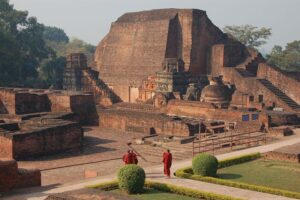
Nalanda was an acclaimed Mahavihara, a large Buddhist monastery in the ancient kingdom of Magadha (modern-day Bihar) in India and was a centre of learning from the seventh century BCE to c. 1200 CE. It is a UNESCO World Heritage Site.
It was the first residential international university in the world. The ancient site is located about 88 kms to Patna. It was the birth place of Sariputra one of the Chief disciples of the Buddha who also attained Nirvana here. The word ‘Nalanda’ has been derived from Na-Alam-Da meaning ‘insatiable in giving’. It is one of the major pilgrimage centres of the Buddhists as the land had been blessed by the presence of the Buddha who also delivered many sermons there. The great monastic university became the crown jewel of the development of Buddhism in India. It attracted a number of Buddhist students from all over the world. The main courses taught here were the Buddhist scriptures along with Vedas, Shabda Vidya(grammar), Chikitsa Vidya(medicine) etc. Nalanda flourished under the patronage of the Gupta Empire in the 5th and 6th centuries and later under Harsha, the emperor of Kannauj. The liberal cultural traditions inherited from the Gupta age resulted in a period of growth and prosperity until the ninth century. The subsequent centuries were a time of gradual decline, a period during which the tantric developments of Buddhism became most pronounced in eastern India under the Pala Empire
History
Many famous events with the Buddha have been associated with this place. It is said that Buddha met Maha Kassapa who later on became one of his close disciples a few kms from Nalanda. A short distance from Nalanda is the village of Kul which is the Kolita of the past and the birthplace of Moggallana one of the Chief disciples of the Buddha. The famous Chinese pilgrims Fa Hien and Hsuan Tsang were among the distinguished students of the Nalanda University. Their travelogues give detailed descriptions of the place and the events prevailing at that time.
Excavation of the place has revealed many monasteries, stupas, staircases, hostels, meditation halls, lecture halls etc built in the old Kushan architectural styles which depict the splendour and grandeur of the place in the past. Hsuan Tsang mentions many Stupas constructed to commemorate different events that took place with the Buddha. Pali Buddhist literature has ample references of Nalanda.
It was apparently a great place of pilgrimage, a prosperous temple city and the site of a celebrated University. King Ashoka is said to have given offerings to the Chaitya of Sariputra at Nalanda and built a temple there. It also mentions Nagarjuna the famous Mahayana philosopher who studied at Nalanda and became the Abbott there. King Harshavardhan gifted a 25m high copper statue of Buddha. Dharmapala the Buddhist scholar taught at Nalanda.
Now at present the entire Nalanda site has been divided into a number of sites that include 11 monasteries and several temples built in red bricks.
Source:
http://www.indianscriptures.com/sacred-places/buddhist-places-of-pilgrimage/nalanda
https://en.wikipedia.org/wiki/Nalanda
http://www.explorebihar.in/nalanda-history.html


